1 Introduction
Radiation hazards have been identified by the World Health Organization (WHO) as one of the four environmental safety issues facing humans alongside “water, air, and noiseâ€. Optical radiation is an important component of radiation and the closest radiation band to human contact. The problem of optical radiation safety studied in the field of light source and illumination is mainly the damage of optical radiation to the human body.
Light radiation hazards include damage to human tissues caused by ultraviolet light, visible light and infrared light radiation. The general research objects are mainly human eyes and skin. The eye is one of the most important sensory organs of human beings. Its structure is very complicated, and its self-repairing ability is weak. It is most vulnerable to optical radiation. For example, excessive blue light can easily cause photochemical damage of photoreceptor cells on the retina, which is too strong. Thermal radiation can cause thermal damage to the retina and the like. The corresponding relationship between the optical radiation band and the eye action area is shown in Fig. 1.

Figure 1 Optical radiation band and eye area
In recent years, international photobiology research has developed rapidly, especially after the study of human third non-visual cells, the effects of light radiation on circadian rhythms and endocrine systems, and the use of light sources and potential. The problem is more important. The main known causes of light radiation hazards are: photokeratitis and photoconjunctivitis, cataracts, retinal burns, retinal blue light damage, skin tanning, ultraviolet erythema, skin aging, skin cancer and the like.
2 LED car headlights radiation safety standardization status
2.1 LED Optical Radiation Safety International Research Institute
(1) International Commission on Non-Ionizing Radiation Protection (ICNIRP)
ICNIRP provides recommended exposure limits based on an assessment of biophysical data and publishes guidelines for the safety of optical radiation for incoherent sources and laser beams. For LEDs, ICNIRP recommends following the guidelines for incoherent sources.
(2) International Commission on Illumination (CIE)
The sixth division of CIE established a corresponding technical committee to study the evaluation of LED light radiation on human eye damage. In 2002, the photobiosafety standard CIE S009 for incoherent light sources such as LEDs was released and recommended to IEC as an industry standard.
(3) International Electrotechnical Commission (IEC)
Since 1993, the optical radiation safety requirements for LED products have been incorporated into IEC 60825 "Safety of Laser Products" and are specified in accordance with the requirements of laser products. However, LEDs are different from lasers. Therefore, in the second edition of IEC 60825-1, "Safety of Laser Products, Part 1 Equipment Classification and Requirements", released in 2007, LED products are no longer considered in terms of laser products. At the IEC/TC76 meeting held in October 2008, it was officially decided to include the optical radiation safety of all LED products in the scope of the non-laser product standard IEC 62471 "Photobiosafety of lamps and lamp systems".
In recent years, IEC/TC76 has accelerated the standardization of photobiosafety. The research and standardization of photobiosafety of LED has become a hot topic of CIE and IEC, and related photobiosafety standards have also been promulgated.
In June 2012, the IEC issued IEC/TR 62778, “Application of IEC 62471 for Blue Light to Light Sources and Luminairesâ€, as an evaluation guide for the blue light hazard of light sources and lamps, which is important for blue light evaluation of light sources and lamps. Guiding significance.
2.2 Status of domestic standardization
In 2006, China issued the GB/T 20145-2006 "Photobiosafety of Lamps and Lamp Systems" as a general safety standard for all lamps and lighting equipment.
At present, the direct related standard for LED automotive headlamps is GB 25991-2010 "LED headlamps for automobiles" released in 2011, which is a general requirement for automotive LED headlamps and LED modules and electronic light source controllers. Regulations, light distribution performance, color, light source, color rendering, light distribution performance stability, illuminance and chromaticity temperature stability of automotive LED headlamps, plastic illuminators and plastic optical components, temperature cycle resistance The polarity requirements, polarity reversal and overvoltage have put forward technical requirements and specified the corresponding test methods, but the standard does not cover the optical radiation safety requirements and measurement methods of LED automotive headlamps.
3 LED car headlights radiation safety research
3.1 LED car headlights radiation radiation hazard main source
The main optical radiation hazards proposed in IEC 62471-2006:
Photochemical hazards of skin and eyes (200~400 nm);
Near-UV hazard of the eye (315~400 nm); photochemical hazard of retinal blue light (300~700 nm);
Omentum blue photochemical hazard contains small light source (300~700 nm);
Retinal heat hazard (380~1 400 nm);
Retinal thermal hazard weak visual stimulation (780 ~ 1 400 nm);
Infrared radiation hazard of the eye (780~3 000 nm);
Skin heat hazard (380~3 000 nm).
At present, the mainstream white LED technology for lighting uses blue LED chips to excite yellow phosphors to form white light. White LEDs using this technology have a strong peak in the short-wave blue light band when the color temperature is high, as shown in Figure 2. For the 5 186 K high color temperature LED light source, the peak wavelength is around 440 nm, and the retinal blue photochemical hazard (abbreviated as blue light hazard) is the most important type of hazard.

Fig. 2 Relative spectral energy distribution of LED light source with color temperature of 5186K
Another white LED technology (such as UV LED technology to stimulate red, green and blue phosphors) in addition to the need to consider the blue light hazard also need to consider the UV hazard, but the technology is not yet fully mature, this article will not be discussed.
Therefore, the research on the safety of LED backlight illumination for automotive is mainly aimed at the research of its blue light hazard.